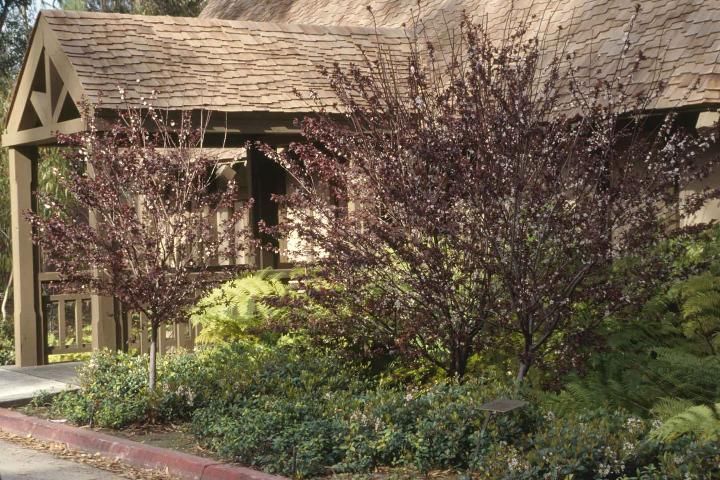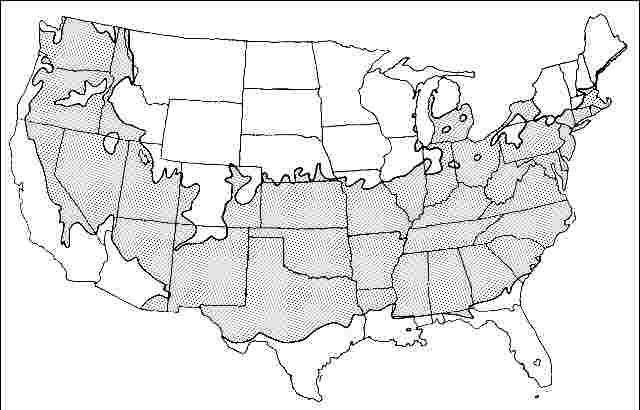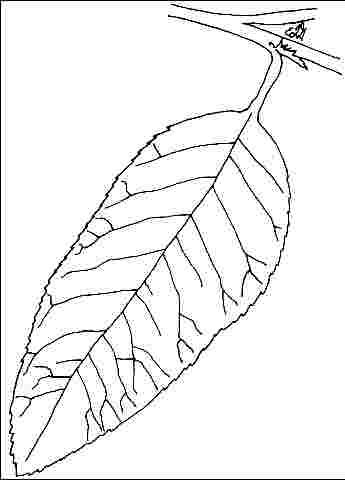Introduction
Purple-leaved plum has new foliage which unfolds as ruby red, then turns reddish-purple, and finally matures to greenish-bronze by the end of the summer. Its fast growth rate and upright to upright-spreading nature quickly forms a 15 to 25-foot-tall, dense silhouette. The small, white to light pink, springtime flowers, which usually appear before the leaves unfold, are followed by a heavy crop of edible, one-inch-diameter purple fruits. They make a temporary mess beneath the tree as they mature and drop during the summer.

Credit: Ed Gilman
General Information
Scientific name: Prunus cerasifera
Pronunciation: PROO-nus sair-uh-SIFF-er-uh
Common name(s): Pissard Plum, `Atropurpurea' Cherry Plum
Family: Rosaceae
USDA hardiness zones: 5B through 8A (Fig. 2)
Origin: not native to North America
Invasive potential: little invasive potential
Uses: specimen; container or planter; Bonsai; shade
Availability: not native to North America

Description
Height: 15 to 25 feet
Spread: 15 to 25 feet
Crown uniformity: symmetrical
Crown shape: round, vase
Crown density: dense
Growth rate: moderate
Texture: medium
Foliage
Leaf arrangement: alternate (Fig. 3)
Leaf type: simple
Leaf margin: serrate
Leaf shape: ovate, elliptic (oval), obovate
Leaf venation: pinnate, brachidodrome
Leaf type and persistence: deciduous
Leaf blade length: less than 2 inches, 2 to 4 inches
Leaf color: purple/red
Fall color: purple
Fall characteristic: showy

Flower
Flower color: white/cream/gray, pink
Flower characteristics: showy
Fruit
Fruit shape: round
Fruit length: 1 to 3 inches
Fruit covering: fleshy
Fruit color: purple
Fruit characteristics: attracts birds; not showy; fruit/leaves a litter problem
Trunk and Branches
Trunk/bark/branches: branches don't droop; not showy; typically one trunk; thorns
Pruning requirement: little required
Breakage: resistant
Current year twig color: reddish, brown
Current year twig thickness: thin
Wood specific gravity: unknown
Culture
Light requirement: full sun
Soil tolerances: clay; sand; loam; acidic; slightly alkaline; well-drained
Drought tolerance: moderate
Aerosol salt tolerance: moderate
Other
Roots: not a problem
Winter interest: no
Outstanding tree: no
Ozone sensitivity: unknown
Verticillium wilt susceptibility: susceptible
Pest resistance: sensitive to pests/diseases
Use and Management
Very popular due to the unusual leaf color, many gardeners want one of these things in their yard. But one plant really attracts attention to an area, and it can be overpowering in a small landscape creating a cramped feeling. Due to the strong effect, best used in a large-scale landscape as a single specimen, not in a row or mass planting. It makes a nice, small ornamental near the deck or patio but locate it far enough away so dropping fruit will fall on the lawn or in a groundcover bed. Do not rely on this tree to be around for a long time since decline often begins by the time the tree is 10 to 15-years-old.
Purple-leaved plum should be grown in full sun to bring out the richest color of the leaves. Leaves turn almost green in shade and loose the characteristic purple which the buyer is usually looking for. Well-drained soil with an acid pH is preferred but it will grow on slightly alkaline soil. Tolerant of moderate heat and drought, it often succumbs to borers on poor, compacted soil.
Propagation is by cuttings.
Pests
Some of its pests are aphids, borers, scales, mealy bugs, tent caterpillars and many others. This is not a pest-free plant.
Diseases
Pissard plum may be infected with canker and leaf spots.